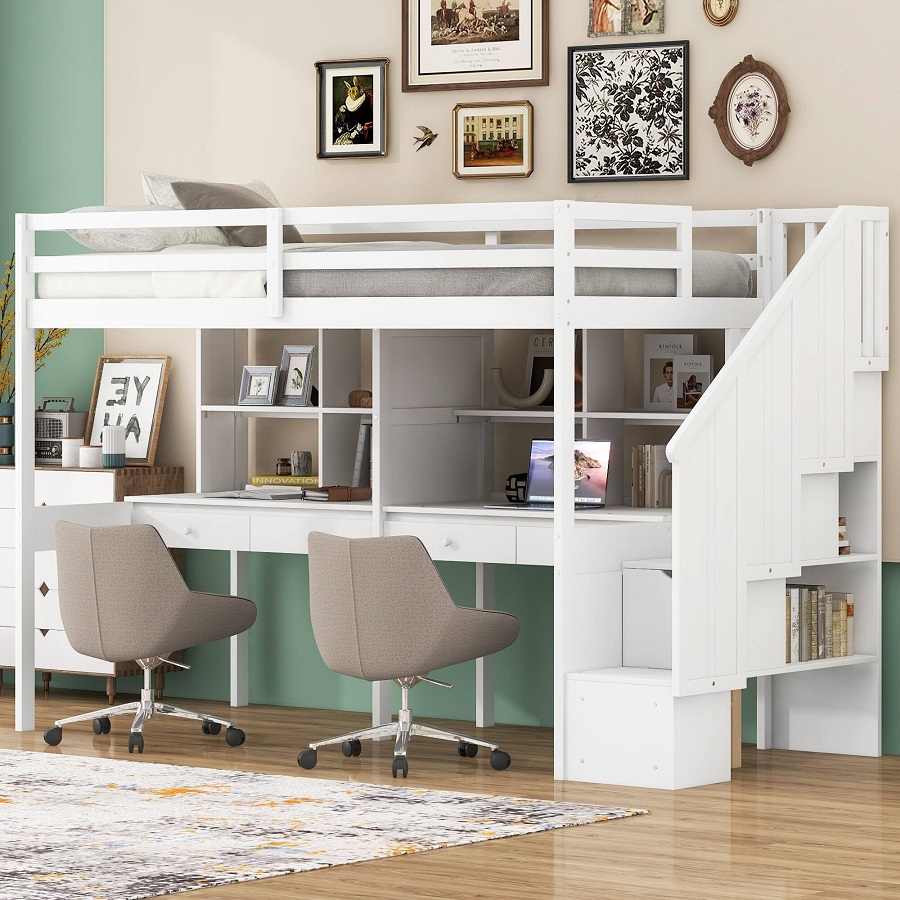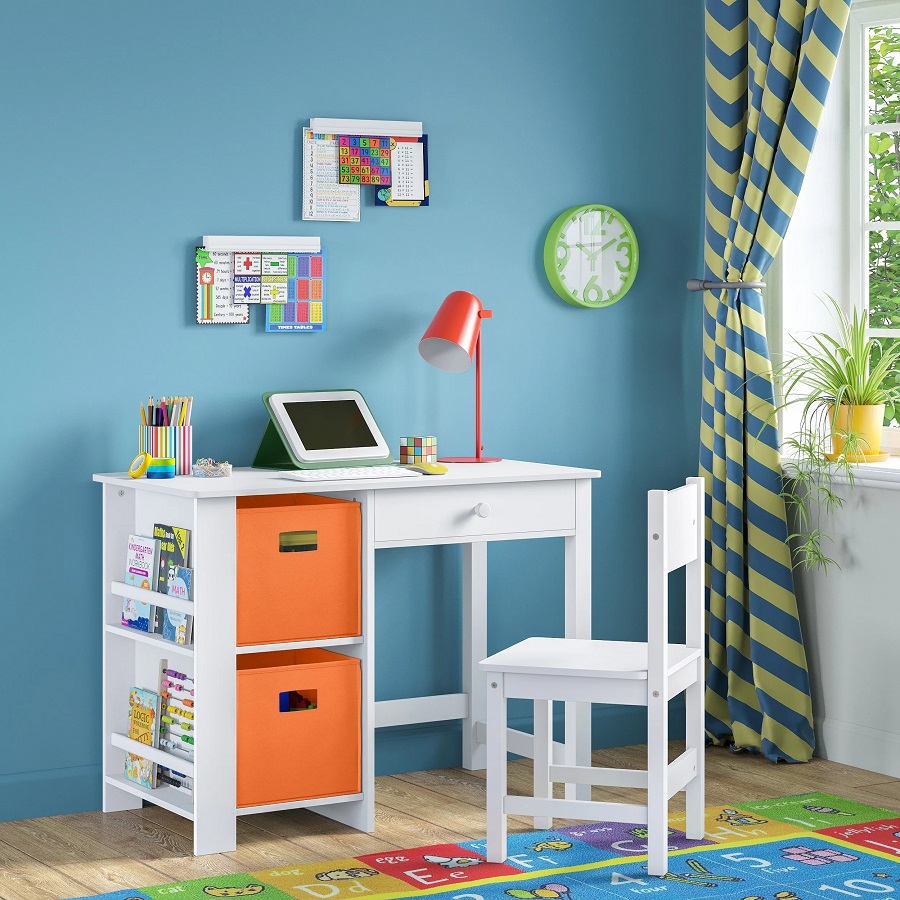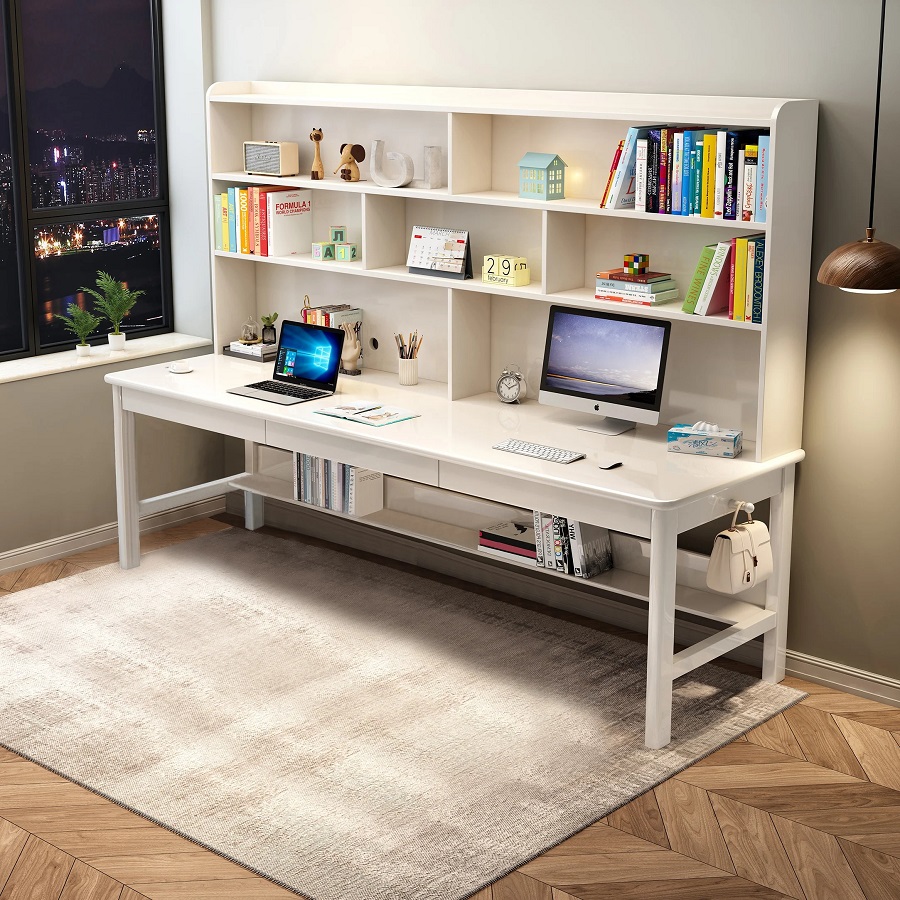The Benefits of a Double Desk Layout for Kids
Creating a shared workspace for kids can be highly beneficial. A kids double desk setup encourages collaboration and bonding between siblings or friends. It’s an efficient way to manage space in a room while catering to the study needs of two children simultaneously.
Here are some advantages of this arrangement:
- Enhanced Collaboration: With a double desk layout, kids can easily work on projects together, share resources and ideas, which can lead to improved learning outcomes.
- Space Efficiency: A single piece of furniture accommodating two users can save much-needed floor space, making it perfect for smaller rooms.
- Cost-Effective: Instead of purchasing two separate desks, a double desk is a one-time investment that serves the purpose of two workstations.
- Simultaneous Supervision: For parents or guardians, it is easier to monitor and assist two kids at once if they are sharing the same workspace.
- Encourages Equal Sharing: A double desk naturally instills a sense of sharing and equality among kids, as they have to cooperatively use the same space.
This layout can be promoted as a practical, space-saving, and collaborative solution for children’s study areas. It is important to highlight these benefits while choosing or designing a desk for kids.

Space-Efficient Double Desk Designs
Choosing a kids double desk that maximizes space requires smart design. Here are some space-efficient designs that might fit into your home:
- Back-to-Back Desks: Position two desks back-to-back to create a central aisle. This layout gives each child their own space while keeping the room open and navigable.
- L-Shaped Arrangement: An L-shaped desk snugly fits into a corner, providing ample workspace for two. It uses the corner space efficiently, a common underutilized area in rooms.
- Vertical Designs: Double desks with a bunk-bed style can have a workspace below and another one built aloft. This design takes up the same floor space as a single desk but doubles the working area.
- Foldable Desks: Desks that fold against the wall or into a cabinet can free up space when not in use. This design is ideal for very tight spaces and multipurpose rooms.
- Shared Long Desk: A long desk with space for two chairs can be an elegant and simple solution. Kids can share the workspace without it feeling cramped.
When integrating a kids double desk, consider the room’s layout and the children’s needs. Picking the right design helps keep the room uncluttered and the kids focused on their tasks.
Criteria for Choosing the Right Kids Double Desk
When shopping for a kids double desk, there are several factors to consider to ensure that the desk you choose fits your children’s needs. These criteria are essential in making an informed decision. Here are some key considerations:
- Size and Dimensions: Measure the available space in the room where the desk will go. Ensure the desk’s size is appropriate for the space and the children using it.
- Durability: Children’s furniture should withstand the wear and tear of daily use. Look for desks made of sturdy materials that can last.
- Adjustability: Choose a double desk with adjustable height. This feature allows the desk to grow with your children and accommodates their changing needs.
- Functionality: A good kids double desk should cater to the tasks at hand, whether it’s drawing, studying, or using a computer. It should have features that support these activities.
- Safety: Safety is paramount. Select desks with rounded corners, stable construction, and no protruding parts that can cause accidents.
- Design Preference: Kids are more likely to use a desk they like. Involve them in choosing a desk with a design that appeals to them and fits your home’s decor.
- Cost: Budget plays a critical role in the decision. Balance quality with affordability to find the best value for money.
Making the right choice involves a mix of practicality, durability, and design appeal. Keep these criteria in mind while selecting a kids double desk and create a positive environment for productivity and learning.
Creative Double Desk Solutions for Small Spaces
Finding the right kids double desk for a small room doesn’t mean sacrificing style or function. Innovative designs can creatively utilize limited space while keeping the area functional and appealing for kids. Let’s explore some smart solutions that address small space challenges:
- Vertical Shelving Units: Desks with integrated vertical shelves make use of upward space. This design keeps essentials within reach without sprawling sideways.
- Corner Desks: A corner kids double desk capitalizes on corner space. By fitting snugly into an underused area, it provides a large working surface.
- Murphy Desks: Desks that fold up into the wall impersonate murphy beds. When not in use, they leave the floor space entirely free.
- Desk Under Loft Bed: A loft bed with a desk underneath is a classic space-saver. This combo frees up the floor space for other activities during the day.
- Pull-Out Desks: These desks slide out from under a platform or another piece of furniture. They remain hidden until needed, keeping the space uncluttered.
- Floating Desks: Mounted directly to the wall, floating desks minimize the footprint. This type leaves the floor more open, making the room look bigger.
Each of these kids double desk ideas maximizes space without compromising the desk’s functionality. When working with small areas, it’s vital to think outside the box to create a comfortable and practical study environment for kids.

Incorporating Storage in Kids Double Desks
Incorporating storage into a kids double desk is one of the smartest ways to keep clutter at bay and maintain an orderly space. When two children share a desk, the need for storage becomes even more critical to ensure that each child has enough room for their supplies. Here are some effective storage solutions to consider:
- Built-in Drawers: Look for a kids double desk with built-in drawers. Each child can have their own set of drawers to store their items.
- Shelving: Adding shelving above or beside the desk can provide ample space for books and other materials. Make sure the shelves are within easy reach for the kids.
- Desk Organizers: Use desk organizers to sort pens, pencils, and other small items. These can fit neatly on the desk without taking too much space.
- Under-Desk Storage: Consider desks with space underneath for storage bins or racks. This area can be used to stow away items that are not in frequent use.
- Cubby Holes: Cubby holes or compartments within the desk can help keep things tidy. They are great for storing paper, art supplies, and electronics.
- Hanging Storage: You can use the sides of the desk to attach hanging storage solutions like file holders or small fabric bins.
When selecting storage options for a kids double desk, remember to think about accessibility and ease of use. The storage should allow the kids to quickly pack away and retrieve their schoolwork and supplies. This not only teaches them organizational skills but also ensures they can focus on their studies without unnecessary distractions caused by a messy workspace. Opt for a kids double desk design that cleverly integrates these storage solutions while still maintaining aesthetics and comfort.
Double Desk Accessories for Enhanced Functionality
To truly harness the benefits of a kids double desk, accessorize for enhanced functionality. Proper accessories can streamline workspace use and encourage better study habits. Here’s what to consider adding:
- Desk Lamps: Lighting is crucial. Individual lamps ensure each child has sufficient light without causing glare to the other.
- Monitor Stands: If computers are used, monitor stands create an ergonomic viewing angle and free up desk space.
- Keyboard Trays: Sliding keyboard trays can help maintain a tidy desk surface and promote better posture.
- Cable Organizers: To prevent tangling, cable organizers keep cords neat and accessible.
- Bulletin Boards: A shared bulletin board can be a central spot for reminders, schedules, or artwork.
- Bookends: Bookends keep books upright and organized, maximizing the desk space.
- Charging Stations: A designated area for charging devices keeps the desk free from clutter.
Adding these accessories to a kids double desk can make a significant difference in how the space is used, supporting kids in their academic endeavors and maintaining an organized environment.

Organizing a shared kids double desk space can be challenging but rewarding. Here are some practical tips to maximize both efficiency and comfort:
- Assign Specific Areas: Clearly define each child’s space at the desk. Use tape or markers to divide the desk surface if needed.
- Color Code Supplies: Assign colors for each child’s supplies. This helps them quickly find what they need and maintains order.
- Implement a Clean Desk Policy: Encourage kids to clear the desk at the end of each day. This habit keeps the space tidy.
- Use Vertical Space: Install shelves or hang organizers above the desk. This capitalizes on vertical space and keeps the desk surface uncluttered.
- Regular Decluttering Sessions: Schedule time each week for kids to sort through their items. This prevents buildup of unnecessary clutter.
- Shared Supply Caddy: A central caddy can hold shared items like scissors and glue. It saves space and promotes sharing.
- Personalize with Care: Allow some personal items but keep them small. Too much decoration can crowd the space.
Staying organized is key to a functional kids double desk. With these tips, children can enjoy a shared workspace that fosters learning and creativity.
The Impact of Desk Layout on Kids’ Productivity and Collaboration
The design of a kids double desk can influence how children interact and work. An optimal layout can promote productivity and enhance collaboration. This can ultimately contribute to better learning outcomes and more harmonious relationships between the children who share the space.
Key factors to consider for a productive and collaborative desk layout include:
- Accessibility: Ensure that all supplies and shared equipment are easily accessible to both children. This reduces time wasted searching for items and allows for smoother cooperation.
- Visibility: The children should be able to see each other easily. This visual contact supports non-verbal communication and makes collaboration more intuitive.
- Equity of Space: Allocate equal space to each child. Symmetrical layouts foster a sense of fairness and can reduce conflicts.
- Flexibility: A layout that can be adapted for different activities, like spreading out project materials or setting up laptops, can handle diverse tasks and support various learning styles.
- Minimized Distractions: Orient the desks in a way that minimizes distractions from the room. This helps maintain focus on studying or project work.
- Group Dynamics: Consider the personalities and work habits of the children. Some may work better side-by-side, while others thrive with a little personal space.
A carefully chosen kids double desk layout not only impacts the individual productivity of each child but also plays a role in how they interact and work together. By balancing accessibility and personal space, children can engage in collaborative tasks with ease, contributing to their overall development and academic success.